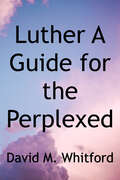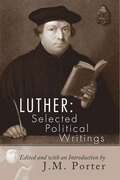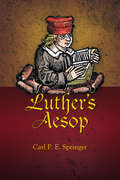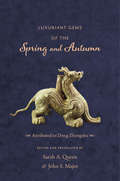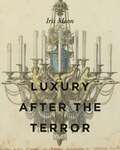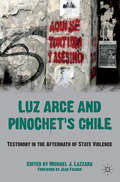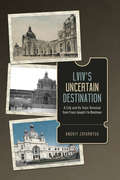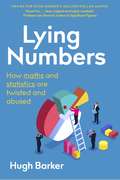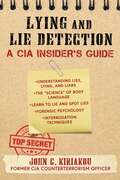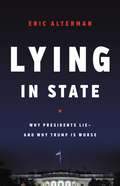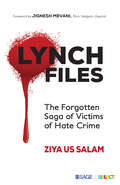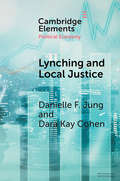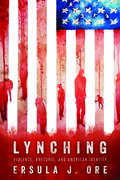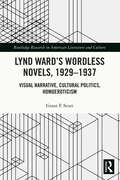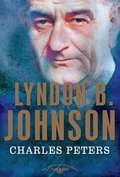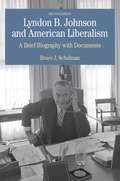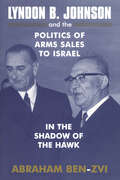- Table View
- List View
Luther: A Guide for the Perplexed (Guides for the Perplexed)
by David M. WhitfordThis is an upper-level introduction to the German Reformer Martin Luther, who by his thought and action started the Reformation movement. <p><p>Martin Luther was one of the most influential and important figures of the second millennium. His break with Rome and the development of separate Evangelical churches affected not just the religious life of Europe but also social and political landscapes as well. <p><p>More books have been written about Luther than nearly any other historical figure. Despite all these books, Luther remains an enigmatic figure. This book proposes to examine a number of key moments in Luther's life and fundamental theological positions that remain perplexing to most students. <p><p>This book will also present an introduction to the primary sources available to a student and important secondary works that ought to be consulted. Continuum's Guides for the Perplexed are clear, concise and accessible introductions to thinkers, writers and subjects that students and readers can find especially challenging - or indeed downright bewildering. Concentrating specifically on what it is that makes the subject difficult to grasp, these books explain and explore key themes and ideas, guiding the reader towards a thorough understanding of demanding material.
Luther: Selected Political Writings: Selected Political Writings
by Martin LutherMartin Luther, pivotal figure of the sixteenth-century Reformation, continues to exercise a powerful influence in the affairs of the twentieth century, not just in the area of religion but also in the political sphere. The direction and desirability of that influence is a matter of dispute. J. M. Porter, a political scientist, here presents revealing selections from nine of Luther's more important writings, all excerpted from the American Edition of 'Luther's Works.' His texts suggest the complexity of the Reformer's thinking, its theological base, and the situational focus of his political utterances. Professor Porter also provides a helpful introduction in which he clarifies the meaning and implications of Luther's famous "two kingdoms" theory, whereby the state is freed both from domination by the church and from the temptation to dominate the conscience of its citizens. Here are to be found generous excerpts from the seminal writings which shaped the Reformation and continue to influence the course of events in our time. They illustrate Luther's innovative ideas about the nature of temporal authority, political obligation and its limits, church-state relations, and political resistance, Luther's plain and often pungent words will be of interest to students of history, religion, political science, and ethics - to everyone concerned about the issues of freedom and authority, ideology and politics, violence and nonviolence, war and freedom.
Luther’s Aesop (Early Modern Studies #8)
by Carl P. SpringerReformer of the church, biblical theologian, and German translator of the Bible Martin Luther had the highest respect for stories attributed to the ancient Greek author Aesop. He assigned them a status second only to the Bible and regarded them as wiser than "the harmful opinions of all the philosophers." Throughout his life, Luther told and retold Aesop’s fables and strongly supported their continued use in Lutheran schools. In this volume, Carl Springer builds on the textual foundation other scholars have laid and provides the first book in English to seriously consider Luther’s fascination with Aesop’s fables. He looks at which fables Luther knew, how he understood and used them, and why he valued them. Springer provides a variety of cultural contexts to help scholars and general readers gain a deeper understanding of Luther’s appreciation of Aesop.
Luther’s Aesop (Early Modern Studies)
by Carl P. SpringerReformer of the church, biblical theologian, and German translator of the Bible Martin Luther had the highest respect for stories attributed to the ancient Greek author Aesop. He assigned them a status second only to the Bible and regarded them as wiser than "the harmful opinions of all the philosophers." Throughout his life, Luther told and retold Aesop’s fables and strongly supported their continued use in Lutheran schools. In this volume, Carl Springer builds on the textual foundation other scholars have laid and provides the first book in English to seriously consider Luther’s fascination with Aesop’s fables. He looks at which fables Luther knew, how he understood and used them, and why he valued them. Springer provides a variety of cultural contexts to help scholars and general readers gain a deeper understanding of Luther’s appreciation of Aesop.
Luther’s Legacy: The Thirty Years War and the Modern Notion of ‘State’ in the Empire, 1530s to 1790s
by Robert Von FriedeburgIn this new account of the emergence of a distinctive territorial state in early modern Germany, Robert von Friedeburg examines how the modern notion of state does not rest on the experience of a bureaucratic state-apparatus. It emerged to stabilize monarchy from dynastic insecurity and constrain it to protect the rule of law, subjects, and their lives and property. Against this background, Lutheran and neo-Aristotelian notions on the spiritual and material welfare of subjects dominating German debate interacted with Western European arguments against 'despotism' to protect the lives and property of subjects. The combined result of this interaction under the impact of the Thirty Years War was Seckendorff's Der Deutsche Fürstenstaat (1656), constraining the evil machinations of princes and organizing the detailed administration of life in the tradition of German Policey, and which founded a specifically German notion of the modern state as comprehensive provision of services to its subjects.
Luxembourg: Selected Issues
by International Monetary FundA report from the International Monetary Fund.
Luxuriant Gems of the Spring and Autumn (Translations from the Asian Classics)
by Zhongshu DongThe Spring and Autumn (Chunqiu) is a chronicle kept by the dukes of the state of Lu from 722 to 481 B.C.E. Luxuriant Gems of the "Spring and Autumn" (Chunqiu fanlu) follows the interpretations of the Gongyang Commentary, whose transmitters sought to explicate the special language of the Spring and Autumn. The work is often ascribed to the Han scholar and court official Dong Zhongshu, but, as this study reveals, the text is in fact a compendium of writings by a variety of authors spanning several generations. It depicts a utopian vision of a flourishing humanity that they believed to be Confucius's legacy to the world.The Gongyang masters thought that Confucius had written the Spring and Autumn, employing subtle phrasing to indicate approval or disapproval of important events and personages. Luxuriant Gems therefore augments Confucian ethical and philosophical teachings with chapters on cosmology, statecraft, and other topics drawn from contemporary non-Confucian traditions. A major resource, this book features the first complete English-language translation of Luxuriant Gems, divided into eight thematic sections with introductions that address dating, authorship, authenticity, and the relationship between the Spring and Autumn and the Gongyang approach. Critically illuminating early Chinese philosophy, religion, literature, and politics, this book conveys the brilliance of intellectual life in the Han dynasty during the formative decades of the Chinese imperial state.
Luxury After the Terror
by Iris MoonWhen Louis XVI was guillotined on January 21, 1793, vast networks of production that had provided splendor and sophistication to the royal court were severed. Although the king’s royal possessions—from drapery and tableware to clocks and furniture suites—were scattered and destroyed, many of the artists who made them found ways to survive. This book explores the fabrication, circulation, and survival of French luxury after the death of the king.Spanning the final years of the ancien régime from the 1790s to the first two decades of the nineteenth century, this richly illustrated book positions luxury within the turbulent politics of dispersal, disinheritance, and dispossession. Exploring exceptional works created from silver, silk, wood, and porcelain as well as unrealized architectural projects, Iris Moon presents new perspectives on the changing meanings of luxury in the revolutionary and Napoleonic periods, a time when artists were forced into hiding, exile, or emigration. Moon draws on her expertise as a curator to revise conventional accounts of the so-called Louis XVI style, arguing that it was only after the revolutionary auctions liquidated the king’s collections that their provenance accrued deeper cultural meanings as objects with both a royal imprimatur and a threatening reactionary potential.Lively and accessible, this thought-provoking study will be of interest to curators, art historians, scholars, and students of the decorative arts as well as specialists in the French Revolution.
Luxury After the Terror
by Iris MoonWhen Louis XVI was guillotined on January 21, 1793, vast networks of production that had provided splendor and sophistication to the royal court were severed. Although the king’s royal possessions—from drapery and tableware to clocks and furniture suites—were scattered and destroyed, many of the artists who made them found ways to survive. This book explores the fabrication, circulation, and survival of French luxury after the death of the king.Spanning the final years of the ancien régime from the 1790s to the first two decades of the nineteenth century, this richly illustrated book positions luxury within the turbulent politics of dispersal, disinheritance, and dispossession. Exploring exceptional works created from silver, silk, wood, and porcelain as well as unrealized architectural projects, Iris Moon presents new perspectives on the changing meanings of luxury in the revolutionary and Napoleonic periods, a time when artists were forced into hiding, exile, or emigration. Moon draws on her expertise as a curator to revise conventional accounts of the so-called Louis XVI style, arguing that it was only after the revolutionary auctions liquidated the king’s collections that their provenance accrued deeper cultural meanings as objects with both a royal imprimatur and a threatening reactionary potential.Lively and accessible, this thought-provoking study will be of interest to curators, art historians, scholars, and students of the decorative arts as well as specialists in the French Revolution.
Luz Arce and Pinochet’s Chile
by Michael J. LazzaraA timely investigation of dictatorship, political upheaval, and human rights in Latin America, with a first hand account from Luz Arce, a controversial figure in Chile's history and culture.
Lviv’s Uncertain Destination: A City and Its Train Terminal from Franz Joseph to Brezhnev
by Andriy ZayarnyukLviv’s Uncertain Destination examines the city’s tumultuous twentieth-century history through the lens of its main railway terminal. Whereas most existing studies of eastern European cities centre their stories on discrete ethnic groups, milestone political events, and economic changes, this book’s narrative is woven around an important site within the city’s complex spatial matrix. Combining architectural, economic, social, and everyday life history, Andriy Zayarnyuk shows how different political regimes created dissimilar social spaces even on the same streets and in the same buildings. His narrative leads us to rethink how the late imperial Habsburg and Romanov, Stalinist and post-Stalinist Soviet, interwar Polish, and Nazi German regimes produced, structured, and controlled urban space. Focusing on railway workers, the book also draws attention to the history of Lviv’s wage earners, who constituted the majority of the city’s adult population.
Lying Numbers: How Maths and Statistics Are Twisted and Abused
by Hugh BarkerA readily understandable exploration of how figures are badly reported or deliberately misrepresented everywhere from political arguments and briefings to business presentations and shopping offers.Praise for Hugh Barker's Million Dollar Maths:'Great fun. A clear, original and highly readable account of the curious relationship between mathematics and money.' Professor Ian Stewart - author of Significant Figures'A lively crash course in the mathematics of gambling, investing, and managing. Hugh Barker makes deep ideas fun and profitable.' William Poundstone - author of How to Predict the UnpredictablePoliticians, economists, scientists, journalists . . . all of them have been known to bend the truth and to twist the facts from time to time. But surely the numbers and statistics they rely on are cold, hard objective facts that tell the real story? Of course the truth is much murkier than that. Figures can be misinterpreted, misunderstood, misconstrued and misused in hundreds of different ways. This book takes a look at the many ways that statistical information can be badly reported or deliberately misused in all walks of life, from political arguments, to business presentations, to more local concerns such as shopping offers and utility bills. A polemical guide to how numbers are used to mislead, which is intended to help the reader through the minefield of dubious stats and lying numbers.
Lying Numbers: How Maths and Statistics Are Twisted and Abused
by Pocket Book of R Hugh BarkerA readily understandable exploration of how figures are badly reported or deliberately misrepresented everywhere from political arguments and briefings to business presentations and shopping offers.Praise for Hugh Barker's Million Dollar Maths:'Great fun. A clear, original and highly readable account of the curious relationship between mathematics and money.' Professor Ian Stewart - author of Significant Figures'A lively crash course in the mathematics of gambling, investing, and managing. Hugh Barker makes deep ideas fun and profitable.' William Poundstone - author of How to Predict the Unpredictable Politicians, economists, scientists, journalists . . . all of them have been known to bend the truth and to twist the facts from time to time. But surely the numbers and statistics they rely on are cold, hard objective facts that tell the real story? Of course the truth is much murkier than that. Figures can be misinterpreted, misunderstood, misconstrued and misused in hundreds of different ways. This book takes a look at the many ways that statistical information can be badly reported or deliberately misused in all walks of life, from political arguments, to business presentations, to more local concerns such as shopping offers and utility bills. A polemical guide to how numbers are used to mislead, which is intended to help the reader through the minefield of dubious stats and lying numbers.
Lying and Lie Detection: A CIA Insider's Guide
by John KiriakouA foolproof guide both to lying and to detecting deception,Lying and Lie Detection: A CIA Insider's Guide will teach you how the pros can tell if and when somebody is lying. People lie all the time. Studies show that the average American lies between six and twenty times a day. Most lies are of the &“little white&” variety or are meant to spare a person&’s feelings. But what about the big lies? What about the consequential ones? You have a right to know when somebody is lying to you. Now, imagine if you had the tools to spot a lie from the truth—a guide to perfect your sixth sense. Whether it's finding out if you truly got the job, unmasking an infidelity, or a simple recommendation, you will no longer have to spend hours, days, or even weeks pondering about it. Through the easy-to-follow instructions and professional anecdotes in Lying and Lie Detection: A CIA Insider's Guide, you&’ll learn to lie and spot lies from John Kiriakou, a former CIA counterterrorism officer and senior investigator for the Senate Foreign Relations Committee responsible for the capture of Abu Zubaydah.Remember, CIA operations officers are trained to lie. They lie all the time. When they are working undercover, they are actually living a lie. With the CIA as a teacher, you&’ll learn how to tell.
Lying in State: Why Presidents Lie -- And Why Trump Is Worse
by Eric AltermanThis definitive history of presidential lying reveals how our standards for truthfulness have eroded -- and why Trump's lies are especially dangerous.If there's one thing we know about Donald Trump, it's that he lies. But he's by no means the first president to do so. In Lying in State, Eric Alterman asks how we ended up with such a pathologically dishonest commander in chief, showing that, from early on, the United States has persistently expanded its power and hegemony on the basis of presidential lies. He also reveals the cumulative effect of this deception-each lie a president tells makes it more acceptable for subsequent presidents to lie-and the media's complicity in spreading misinformation. Donald Trump, then, represents not an aberration but the culmination of an age-old trend. Full of vivid historical examples and trenchant analysis, Lying in State is essential reading for anyone seeking to understand how we arrived in this age of alternative facts.
Lyle Creelman
by Susan E. Armstrong-ReidThis intriguing scholarly biography examines the important contributions of Canada's foremost international nurse, Lyle Creelman. Creelman parlayed her experience as a community health nurse in British Columbia into significant international appointments with two organizations undertaking massive responsibility for health tasks in the post-war period - first, as chief nurse of the British Zone of Occupied Germany with the United Nations Relief and Rehabilitation Administration (UNRRA), and, from 1954 to 1968, the Chief Nursing Officer of the World Health Organization (WHO).In telling Creelman's fascinating story, Susan Armstrong-Reid helps readers learn about the transformation of the nursing profession and global health governance in the twentieth century. This story challenges the prevailing portrait of expatriate nurses during this period as agents of Western cultural imperialism. Lyle Creelman: The Frontiers of Global Nursing not only recasts the broader historical narrative of nursing's legacy to global health, but contextualizes its continuing importance for approaching health care in the twenty-first-century.
Lynch Files: The Forgotten Saga of Victims of Hate Crime
by Ziya Us SalamMohammed Akhlaq and Rakbar lynched in the name of cow protection. Chimma, a Dalit, lynched by the mob for entering a Hindu temple. In the recent years, the cases of mob lynching of Muslims and Dalits have increased to an alarming extent. These cases are discarded and forgotten without any justice served to the victims. The emergence of mobocracy from the roots of Hindutva and gau rakshaks has put India’s secularity and democratic constitution to test. Lynch Files pieces together the tragic stories of the people at the receiving end of mob violence and looks inside the mind of the lynchers who flout laws with impunity. Further, the book discusses the Supreme Court judgement against lynching and tries to restore faith in the court’s capacity to curb this violence.
Lynching and Local Justice: Legitimacy And Accountability In Weak States (Elements in Political Economy)
by Danielle F. Jung Dara Kay CohenWhat are the social and political consequences of poor state governance and low state legitimacy? Under what conditions does lynching – lethal, extralegal group violence to punish offenses to the community – become an acceptable practice? We argue lynching emerges when neither the state nor its challengers have a monopoly over legitimate authority. When authority is contested or ambiguous, mass punishment for transgressions can emerge that is public, brutal, and requires broad participation. Using new cross-national data, we demonstrate lynching is a persistent problem in dozens of countries over the last four decades. Drawing on original survey and interview data from Haiti and South Africa, we show how lynching emerges and becomes accepted. Specifically, support for lynching most likely occurs in one of three conditions: when states fail to provide governance, when non-state actors provide social services, or when neighbors must rely on self-help.
Lynching: Violence, Rhetoric, and American Identity (Race, Rhetoric, and Media Series)
by Ersula J. OreWinner of the 2020 Rhetoric Society of America Book AwardWhile victims of antebellum lynchings were typically white men, postbellum lynchings became more frequent and more intense, with the victims more often black. After Reconstruction, lynchings exhibited and embodied links between violent collective action, American civic identity, and the making of the nation.Ersula J. Ore investigates lynching as a racialized practice of civic engagement, in effect an argument against black inclusion within the changing nation. Ore scrutinizes the civic roots of lynching, the relationship between lynching and white constitutionalism, and contemporary manifestations of lynching discourse and logic today. From the 1880s onward, lynchings, she finds, manifested a violent form of symbolic action that called a national public into existence, denoted citizenship, and upheld political community.Grounded in Ida B. Wells’s summation of lynching as a social contract among whites to maintain a racial order, at its core, Ore’s book speaks to racialized violence as a mode of civic engagement. Since violence enacts an argument about citizenship, Ore construes lynching and its expressions as part and parcel of America’s rhetorical tradition and political legacy.Drawing upon newspapers, official records, and memoirs, as well as critical race theory, Ore outlines the connections between what was said and written, the material practices of lynching in the past, and the forms these rhetorics and practices assume now. In doing so, she demonstrates how lynching functioned as a strategy interwoven with the formation of America’s national identity and with the nation’s need to continually restrict and redefine that identity. In addition, Ore ties black resistance to lynching, the acclaimed exhibit Without Sanctuary, recent police brutality, effigies of Barack Obama, and the killing of Trayvon Martin.
Lynd Ward’s Wordless Novels, 1929-1937: Visual Narrative, Cultural Politics, Homoeroticism (Routledge Research in American Literature and Culture)
by Grant F. ScottThis book offers the first multidisciplinary analysis of the "wordless novels" of American woodcut artist and illustrator Lynd Ward (1905-1985), who has been enormously influential in the development of the contemporary graphic novel. The study examines his six pictorial novels, each part of an evolving experiment in a new form of visual narrative that offers a keen intervention in the cultural and sexual politics of the 1930s. The novels form a discrete group – much like Beethoven’s piano sonatas or Keats’s great odes – in which Ward evolves a unique modernist style (cinematic, expressionist, futurist, realist, documentary) and grapples with significant cultural and political ideas in a moment when the American experiment and capitalism itself hung in the balance. In testing the limits of a new narrative form, Ward’s novels require a versatile critical framework as sensitive to German Expressionism and Weimar cinema as to labor politics and the new energies of proletarian homosexuality.
Lyndon B. Johnson (The American Presidents Series)
by Arthur M. Schlesinger Charles PetersPeters, a keen observer of Washington politics for more than five decades, shares his insider knowledge and experiences to tell the story of Johnson's presidency as the tale of an immensely talented politician driven by ambition and desire.
Lyndon B. Johnson and American Liberalism: A Brief Biography With Documents (Bedford Series in History and Culture )
by Bruce J. SchulmanWhether admired or reviled, Lyndon B. Johnson and his tumultuous administration embodied the principles and contradictions of his era. Taking advantage of newly released evidence, this second edition incorporates a selection of fresh documents, including transcripts of Johnson's phone conversations and conservative reactions to his leadership, to examine the issues and controversies that grew out of Johnson's presidency and have renewed importance today. The voices of Johnson, his aides, his opponents, and his interpreters address the topics of affirmative action, the United States' role in world affairs, civil rights, Vietnam, the Great Society, and the fate of liberal reform. Additional photographs of Johnson in action complement Bruce J. Schulman's rich biographical narrative, and a chronology, an updated bibliographical essay, and new questions for consideration provide pedagogical support.
Lyndon B. Johnson and the Politics of Arms Sales to Israel: In the Shadow of the Hawk (Israeli History, Politics And Society Ser.)
by Abraham Ben-ZviLyndon B. Johnson and the Politics of Arms Sales to Israel seeks to reconstruct and elucidate the processes behind the decisions made by the Johnson Administration during the years 1965-68 to sell Israel M-48 tanks, A-4 Skyhawk planes and F-4 Phantom planes. This examination is based on a distinction between three factions which competed for influe
Lyndon B. Johnson and the Transformation of American Politics (Library of American Biography Series)
by John BullionThis newest edition to the Library of American Biography Series by John L. Bullion introduces students to the dynamic and turbulent life and legacy of President Lyndon B. Johnson. <P><P>Johnson navigated the country through some of the most challenging issues of the 20th century. This volume offers a close look at not only how Johnson handled the issues of civil rights, segregation, Vietnam, and an unruly economy, but also demonstrates how these same issues and events wore away Johnson’s once robust idealism. <P><P>The titles in the Library of American Biography Series make ideal supplements for American History Survey courses or other courses in American history where figures in history are explored. Paperback, brief, and inexpensive, each interpretative biography in this series focuses on a figure whose actions and ideas significantly influenced the course of American history and national life. At the same time, each biography relates the life of its subject to the broader themes and developments of the times.
Lyndon B. Johnson: Thirty-sixth President Of The United States
by Lucille Falkof Richard G. YoungTraces the childhood, education, employment, and political career of the thirty-sixth president of the United States.
